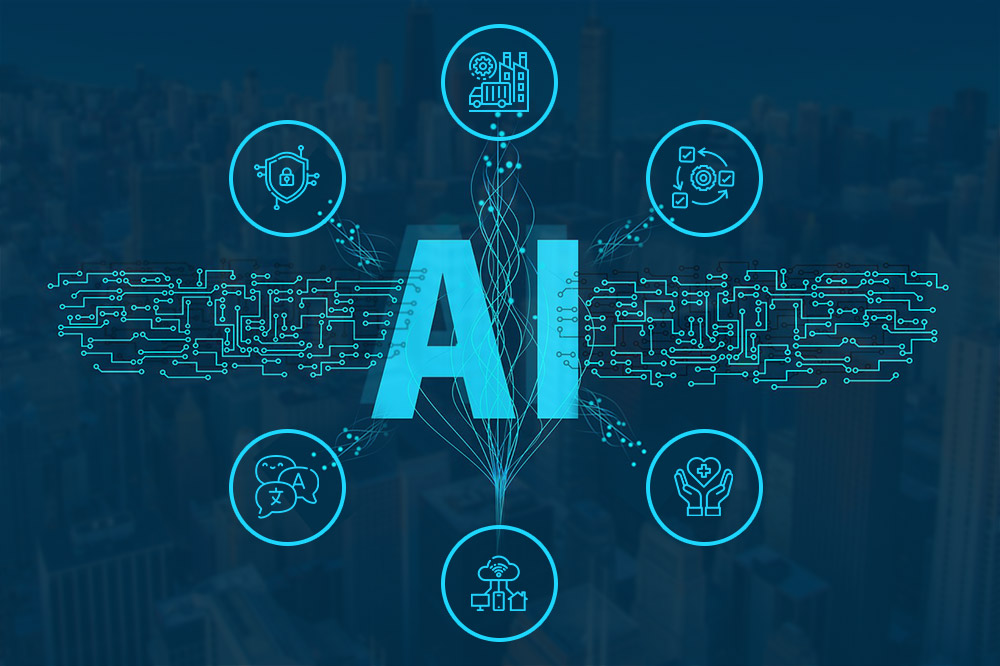Trends of AI in Business: Uses, Benefits, & Challenges

The impacts of AI in business operations today cannot be overstated. Why?
First, using artificial intelligence in business is showing signs of acceleration. About three-quarters of businesses are now using AI or exploring AI uses.
Artificial intelligence (AI) radically transforms how businesses operate, enabling them to automate repetitive tasks, analyze vast amounts of data and make informed decisions. By leveraging AI, businesses can streamline processes, boost productivity and gain a competitive edge.
In this post, I’ll give you an overview of AI in business, its common uses, benefits and real-life AI examples and ways you can use AI to support your business.
What is AI, and how does it help businesses?
Artificial intelligence has a wide range of uses in businesses, including generating content, Keyword research, streamlining job processes and aggregating business data.
To understand AI in business, we must first understand AI.
What is AI (Artificial Intelligence)
Artificial intelligence can perform tasks that typically require human intelligence, such as learning, planning and problem-solving. In short, AI is today at the center of business growth.
So, What is AI in Business?
Artificial intelligence in business involves the application of intelligent computer software with human-like capabilities to perform business activities without human involvement.
How does AI help businesses?
AI enables businesses to improve customer experience, boost revenue, increase productivity and efficiency and drive business growth and transformation. How?
Business processes today have a high level of complexity involving large amounts of data. With vast data, companies can obtain valuable insights to build growth strategies.
Using AI in business, companies can analyze vast amounts of data quickly and in real-time and get actionable insights for better decision-making. This enables businesses to understand and engage customers, automate business processes and improve productivity and revenue while reducing operational expenses.
How Does AI in Business Work?
AI systems work by consuming large data quantities (training data), analyzing the data for correlations and patterns, and using these patterns to predict future states. AI is an interdisciplinary category of computer science with multiple approaches and advancements in key technologies or AI techniques, which include the following:
(1) Machine Learning (ML)
Machine learning (ML) is a subset of AI that involves developing algorithms and models that enable computer systems to learn and make predictions or decisions. It involves developing techniques that automatically allow computers (machines) to learn from data and improve their performance over time. ML algorithms analyze and extract patterns from large datasets to make predictions or take actions based on new inputs.
(2) Deep Learning (DL)
Deep learning is a more advanced type of ML that works through representation but with unstructured data sets. It uses biologically inspired artificial neural network architecture. DL is inspired by the structure and function of the human brain's neural networks. Deep learning algorithms have supported image and speech recognition and NLP tasks.
(3) Natural Language Processing (NLP)
In AI, Natural Language Processing is a linguistic tool in computer science that enables machines to learn, read, understand, interpret, generate and respond to human language. NLP techniques are used in various applications, such as machine translation, sentiment analysis, chatbots and voice assistants.
(4) Computer Vision (CV)
Machine vision (computer vision) is an area in AI that enables computerized machines to understand and interpret visual information from images or videos. Applications of machine vision techniques include object recognition, image classification, video surveillance, autonomous vehicles, medical imaging and others.
Common Uses of AI in Business
AI has become ubiquitous in various aspects of business operations. The use of AI in business operations and applications is expanding. Some of the most common use cases include:
1. Data analytics and business intelligence
With the increasing amount of available business data, finding insights from the data can be quite challenging. This is why many businesses are adopting AI in business intelligence. AI enables organizations to analyze large data volumes and extract valuable insights quickly. These insights help businesses identify trends, make data-driven decisions, and optimize processes. For example, businesses can use AI data to improve marketing, understand customers better, perform segmentation and create personalized experiences.
2. Customer service, experience and support
One of the most common enterprise use cases for AI is in customer experience, service and support. Though still controversial, AI is increasingly replacing humans in customer service. AI-powered technologies such as chatbots, virtual assistants and personalized recommendation systems enhance customer interactions. They provide instant support, tailored recommendations and personalized experiences, leading to higher customer satisfaction and loyalty. For example, the event industry incorporates AI to resolve attendee queries related to the event registration system, payment processing, navigating through the event app, etc.
3. Personalized and targeted marketing with predictive modeling
Targeted marketing is a key application of AI in business. AI algorithms can predict future outcomes based on historical data, allowing businesses to anticipate customer behavior, demand trends and potential risks. This enables proactive decision-making and resource allocation. For example, online search providers, retailers and other internet entities use AI intelligent systems to understand users and their buying patterns.
4. Natural language processing (NLP)
With AI, machines can now read, write and understand languages like humans. AI-powered chatbots and virtual assistants can understand and respond to human language, providing personalized customer support and enhancing user experiences. With advancements in NLP, businesses now offer smart digital assistant products to assist users in routine tasks. These NLP softwares now helps businesses to generate automated business reports without human supervision. They can also conduct sentiment analysis to understand people's perception of brands from various sources such as online comments, tweets, etc.
5. Predictive analytics and product recommendations
To increase marketing effectiveness and customer engagement, businesses recommend products that retain customers' interest and satisfy their desires. Companies like Spotify, Amazon, Netflix, etc., are using AI to understand their customers' habits/behaviors to predict and recommend products.
6. Documentation and Knowledge Base Building
With nocode tools, process documentation and building company knowledge bases is now easier. Scribe, for example, allows you to capture your screen and automatically create how-to guides easily. No code tools also provide adequate cloud document storage and sharing. And with ChatGPT, companies can automate the entire documentation process for documents like standard SOPS, FAQs, training modules, etc.
11 Key Trends of AI in Business
The evolution of artificial intelligence was slow at first, then it became suddenly rapid. Several trends are today shaping AI's application in business. The following are some key trends of AI in business:
1. One-Third of Organizations Use AI
According to an IBM survey, about one-third (31%) of organizations are now using AI, and 43% are exploring how to use the technology. Only about 34% of companies have not deployed any AI projects. Further, bigger businesses are nearly 70% more likely than smaller businesses to have adopted AI. China led in adopting or exploring AI, followed by India and Spain.
The various factors driving AI adoption are:
- Advances making AI more accessible
- Business needs
- Shifting business needs owing to the pandemic
- Automates processes to empower higher-value work
- Provides trust in business outcomes
- Ability to deploy anywhere
2. NLP Is at the Forefront of AI Adoption
Natural language processing (NLP), one of the foundational technologies for AI models, is steadily becoming an important tool for organizations' AI adoption. It’s helping organizations to empower their employees and interact with their customers.
But there are some barriers to NLP adoption, including the following:
- Expensive Technology
- Relevant training requirements
- It is difficult to keep up to date
- Technology is too complex to use
- Lack of requisite tools in the organization
Despite the barriers, many organizations are adopting NLP in AI and automation.
3. Generative AI is Rising
A new area of AI that has recently gained traction is called generative AI used to produce AI-generated content. So, what is generative AI?
Generative AI refers to the use of AI techniques and algorithms to create new and original content, such as images, videos, music, text and websites through AI website builder.
It used ML to process large amounts of visual or textual data, often from the internet, to create the "near equal" content as instructed.
Generative AI has been around since ELIZA, a chatbot, in 1966. But years of AI work and greater ML technologies have led to the recent release of new generative AI systems, such as ChatGPT and more.
Generative AI applications like ChatGPT and Google Bard have applications in creative industries, content generation and simulation. There are even AI content generators that use a fine-tuned model of generative AI to generate long-form content for blogs and websites.
4. Automation AI Technologies are Becoming Deeply Embedded
As more businesses learn about AI’s potential, automation technologies are increasingly embedded in daily operations to increase efficiencies and save costs. Businesses are also using automation for increasingly complex use cases. About 80% of organizations already use or plan to use automation tools.
5. Investments in AI Have Increased
There is an accelerated rollout of AI among organizations, especially after COVID-19. Other factors influencing organizations to adopt AI automation software are improving employee productivity and the requirement for a better way to interact with customers. The following are some key areas where many organizations plan to invest in:
- Generative AI
- Automation or Embedding AI into current AI applications and processes
- No-code tools
- Reskilling and workforce development
- Proprietary AI solutions
- Off-the-shelf AI applications
- Off-the-shelf tools to build their own models and applications
6. Document AI to optimize processing efficiency.
Also known as intelligent document processing (IDP), document AI technology allows businesses to automate and speed up redundant data entry processes. Document AI leverages AI with ML to facilitate data extraction from documents such as invoices, forms, claims, contracts and SOPs. It converts semi-structured and unstructured documents into organized information or structured data the business uses to guide decision-making.
7. Low-code and no-code tech
For decades, software development required knowledge and experience in the coding language. This was a barrier for many people. Today, automation has gone beyond the IT department, and businesses can access optimized or innovative processes. No-code documentation tools like help businesses to leverage AI to build and support their IT and only specialized staff.
8. Increased data sharing and Data Access for AI Projects
AI is likely to pave the way for more data sharing, and there is a need for increased data access for AI projects. Modern businesses continue to collect unprecedented amounts of data to derive valuable insights and guide decision-making through technological advancements, such as edge computing and IoT, have created a data deluge for businesses.
AI technologies in businesses are increasing organizations' capacity to process data and share data and insights. Recent consumer privacy and protection demands fuel the trend of AI-assisted data sharing. For instance, search engines like Google and Safari are banning third-party cookies. Now, companies share data among themselves as long as they follow the required regulations. Add data sharing with AI tools to give businesses more complete insights into their audience.
Organizations also need to make sure this information is accessible, secure, accurately informing their business intelligence (BI), and complying with privacy regulations. The challenge is that this humongous data is spread across extensive IT estates. Organizations say it is very important that they can build and run their AI projects wherever the data resides.
9. End-user tech that democratizes AI
There's debate about the skills gap in fields like analytics and data science that's negatively impacting digital transformation initiatives. Data science candidates now come with a high price tag, demanding high salaries. Fortunately, businesses are finding ways to democratize AI using low-code and no-code technology. As these technologies become more refined, businesses can use them to help close the skills gap. For example, instead of expensive technical writers to develop tech manuals, businesses can use ChatGPT to write their manuals.
10. Businesses balancing automation and augmentation
Businesses are still trying to achieve a balance between AI technologies used in automation and augmentation. While modern AI technologies in business are designed to reduce the need for human input, they should also help businesses increase agility and maximize operational efficiency. But there's still a need for some human input, at least for now. For example, AI-generated content needs human intervention to streamline information. In the future, businesses will strive to learn to balance the two. For example, they can use AI to automate redundant processes and use strategic human augmentation to guide their directions.
11. Companies Face Barriers to AI Adoption
AI adoption may be growing exponentially, but organizations face some challenges when adopting the technology. The top challenges to AI adoption are:
- Limited knowledge or expertise
- Lack of skills
- Increasing data silos
- Data complexity
- Lack of platforms or tools to develop AI models
- AI is highly expensive to implement
Increased data silos, cost, and data complexity form the biggest challenge for AI adoption in business. Limited skills, knowledge or expertise are the largest barrier for smaller organizations.
What does AI mean for Employees?
Integrating AI in business inevitably raises questions about its impact on employees. So, what does AI and the future of work look like?
AI in business is two-way:
- AI may automate certain tasks and make them redundant for human operation.
- AI in business will also create new opportunities for employees to upskill and focus on higher-value activities.
So, rather than replacing jobs, AI can potentially augment human capabilities, enabling employees to work more effectively and creatively while improving business productivity.
While there is still more debate on what the rise of AI in business means for employees, people agree on some trends to be expected.
For example, there's likely to be a shift to more specialized skills and become technology oriented. The workforce may transform and become more specialized. Roles that can't be automated, like creativity, problem-solving and qualitative skills, may become increasingly required in job performance.
5 Real-life examples of AI in business
Here are examples of artificial intelligence in business examples:
1. Recommendations on Netflix, YouTube and Spotify
Netflix, Spotify, YouTube and other streaming services use a user's watch or search history to recommend what to watch based on the user's listening or viewing history. This helps provide personalized content to improve customer experience and satisfaction.
2. eCommerce platforms
Amazon, Alibaba and other eCommerce platforms integrate AI into their platform to enhance customer experiences. Their recommendation engine uses ML algorithms to analyze user browsing and purchase history, providing personalized product recommendations that increase customer engagement and drive sales.
3. AI in Healthcare
Healthcare organizations are leveraging AI for medical image analysis. Medical companies use deep learning algorithms to analyze medical images, helping radiologists detect abnormalities and diagnose diseases more accurately. This improves patient care and reduces the time and effort required for diagnosis. An example is Healthcare BPO.
4. Transportation
There are many ways AI is being applied in transportation businesses, including the following:
- Taxi-hailing apps like Uber leverage AI to predict demand and traffic, reduce estimated arrival time and match riders and drivers.
- Maps use AI navigational systems to improve transport and navigation while providing directions and enhancing traffic detection.
- Self-driving cars like Tesla use AI algorithms to navigate roads and make decisions.
5. Content creation
Tools like Document 360, Scribe, Automateed etc. use a generative AI to help businesses document processes. Businesses can document and share processes, SOPs, FAQs, manaus, etc.
TL; DR: Trends of AI in Business: Uses, Benefits, & Challenges
- Improving the customer experience
- Automating business processes
- Gaining insight through data analysis
- Streamlining job processes
- Aggregating business data
- Turning data into actionable insights
- Increasing leads by more than 50%
- Reducing call time by 60-70%
- Boosting efficiency through process automation
- Improving the speed or consistency of service
- Predictive maintenance
Moreover, 61% of companies use AI to optimize emails, while 55% deploy AI for personalized services, such as product recommendations. Businesses also leverage AI for long-form written content, such as website copy (42%) and personalized advertising (46%).
Conclusion
Artificial intelligence has become a powerful tool for businesses across various industries.
From data analytics, predictive modeling and natural language processing to generative AI, businesses are using AI to automate tasks, improve efficiency and enhance decision-making.
Artificial intelligence is increasingly becoming crucial for organizations in their digital transformation journey. More organizations are either using or exploring AI. Further, AI rollout has accelerated as a result of the COVID-19 pandemic.
Further Reading
» How AI Will Give Superpowers To ERP Solutions
» Top 10 Best Stable Diffusion Models You Need to Try
» Microsoft Office 2021: Here's What You Can Expect
» What Is the Best Cloud Provider for Stable Diffusion?
» 10 Top Digital Marketing Trends and Predictions for 2023










